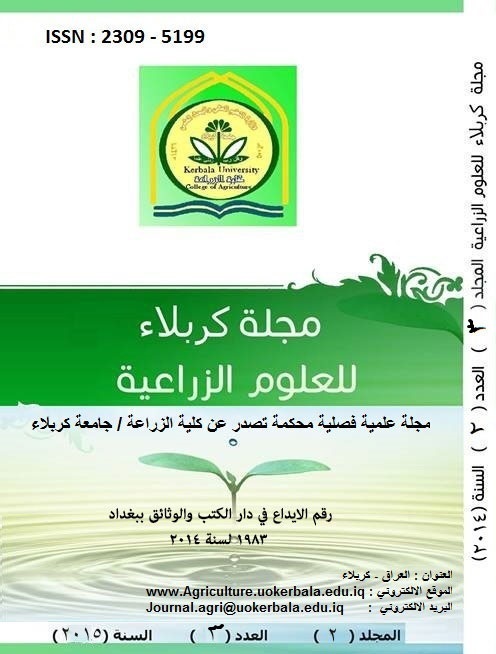Faba bean seed content of amino acid and chemical score effected by Zinc and Boron
DOI:
https://doi.org/10.59658/jkas.v2i3.500Abstract
Samples of faba bean cv. civilian were collected from field experiment carried out on field of department of field crops, college of agriculture-university of Baghdad. Then the samples were subjected to gas chromatography to analyze the essential and non-essential amino acid that formed the protein content and evaluated the chemical scores effected by boron and zinc. Results showed that the two essential amino acids Leucine and Lysine were higher than others essential amino acids of (7.25 and 7.15, and 6.95 and 6.74 g.100g-1), for zinc and boron, respectively. While the sulphur-containing essential amino acid had the lowest content of (0.76 and 0.82 g.100g-1), for zinc and boron, respectively. But this acid was increased by increased boron levels from 0 upto mgB.L-1 of 0.78-0.86g.100g-1protein). Furthermore, the results revealed the predominant amino acids were Glutamine of 17.65 and 17.63 g.100g-1 protein, Asparagine of 10.13 and 10.17 g.100g-1 protein, Arginine of 7.38 and 7.78 g.100g-1 protein and Proline of 6.72 and 6.61g.100g-1 protein, for zinc and boron, respectively. Moreover, the chemical score analysis pointed that the faba bean protein had the highest content of amino acids in comparison with their mirrors in FAO reference. In spite of this increase, the analysis determined that the sulphur-containing amino acid (Methionine) was the limiting essential amino acid in feeding, because of being decreased its chemical score. Thus, it could be concluded that the application of nutrients with spraying or incorporatedly could increase and improve amino acid in protein content which boron proportionally improve the limiting amino acid in feeding. So, the application of good soil and crop management is the best tool for improving faba bean content of amino acids. Therefore, it could be recommended that the minerals should be uniform with spraying and incorporatedly in soil. From other aspect, faba bean could be subjected to breeding program to improve nutritional quality and increase its limited amino acid content.
Downloads
Published
How to Cite
Issue
Section
License
Copyright (c) 2015 Copyright (c) 2024 is the Author's article. Published by the Journal of Kerbala for Agricultural Sciences under a CC BY 4.0 license

This work is licensed under a Creative Commons Attribution 4.0 International License.
Licensing Terms
All articles are published under a Creative Commons License and will be directed to the Creative Commons Attribution 4.0 International License (CC BY 4.0) That permits use, distribution, and reproduction in any medium, provided the original work is properly cited. This license also allows the work to be used for commercial purposes.
Use by both non-commercial and commercial users
This content is licensed under a Creative Commons Attribution 4.0 International (CC BY 4.0) license, permitting use by both non-commercial and commercial users. Individual users may access, download, copy, display, and redistribute the articles to colleagues, as well as adapt, translate, and text- and data-mine the content, subject to the following conditions:
- The author's moral rights, including the right of attribution and the right to protect their work from derogatory treatment, are respected.
- Where content in the article is identified as belonging to a third party, users must ensure that any reuse complies with the copyright policies of the owner of that content.
- If the article content is reused for research or educational purposes, users should maintain a link to the appropriate bibliographic citation, including the DOI and a link to the published version on the journal's website.

